Business Taxation: Adjusted Trading Profit, Self-Employment vs Employment, Badges of Trade
VerifiedAdded on 2023/06/17
|12
|3653
|269
AI Summary
This article discusses adjusted trading profit, self-employment vs employment, and badges of trade in business taxation. It explains the differences between self-employed and employed individuals, and the reasons for preferring self-employment. It also explores the six badges of trade with examples.
Contribute Materials
Your contribution can guide someone’s learning journey. Share your
documents today.
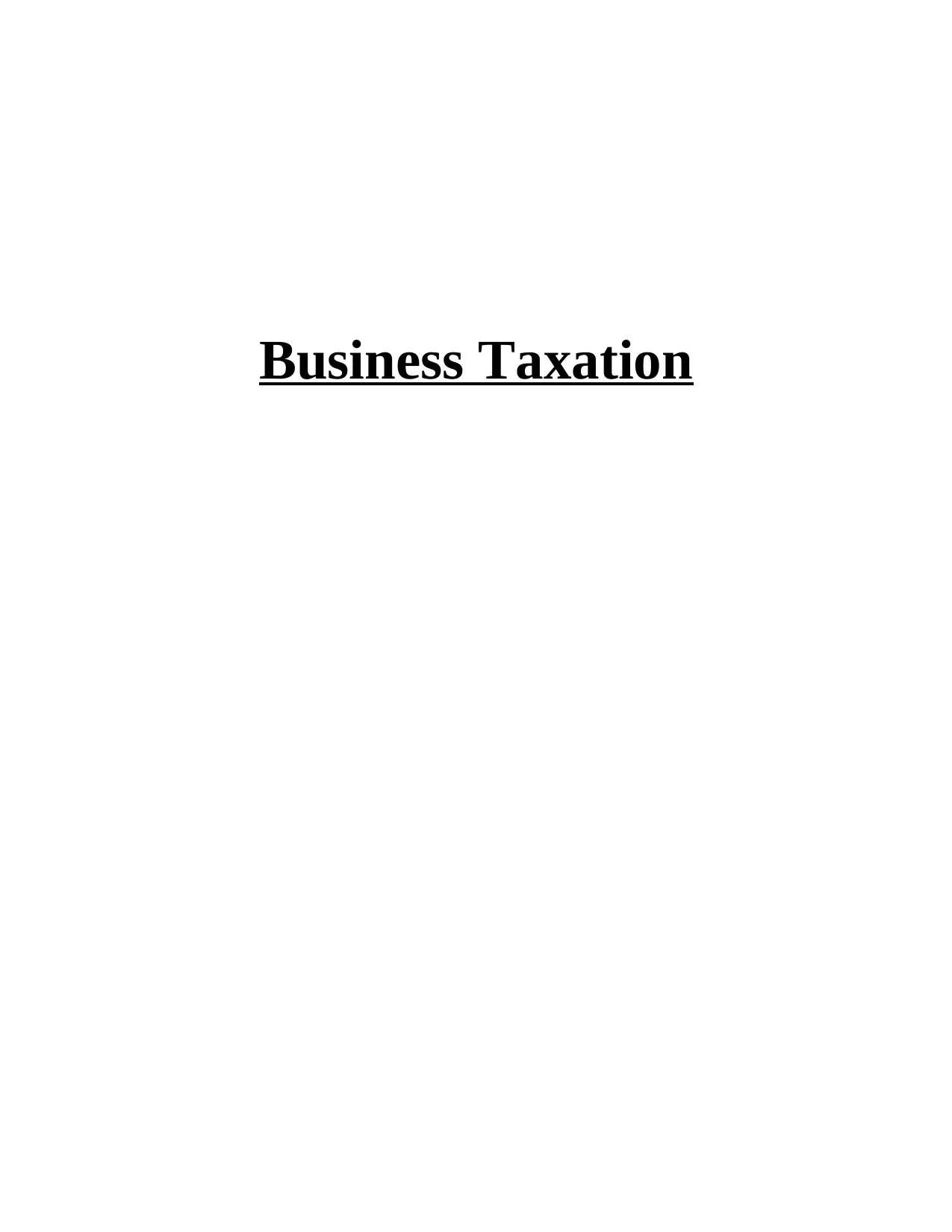
Business Taxation
Secure Best Marks with AI Grader
Need help grading? Try our AI Grader for instant feedback on your assignments.
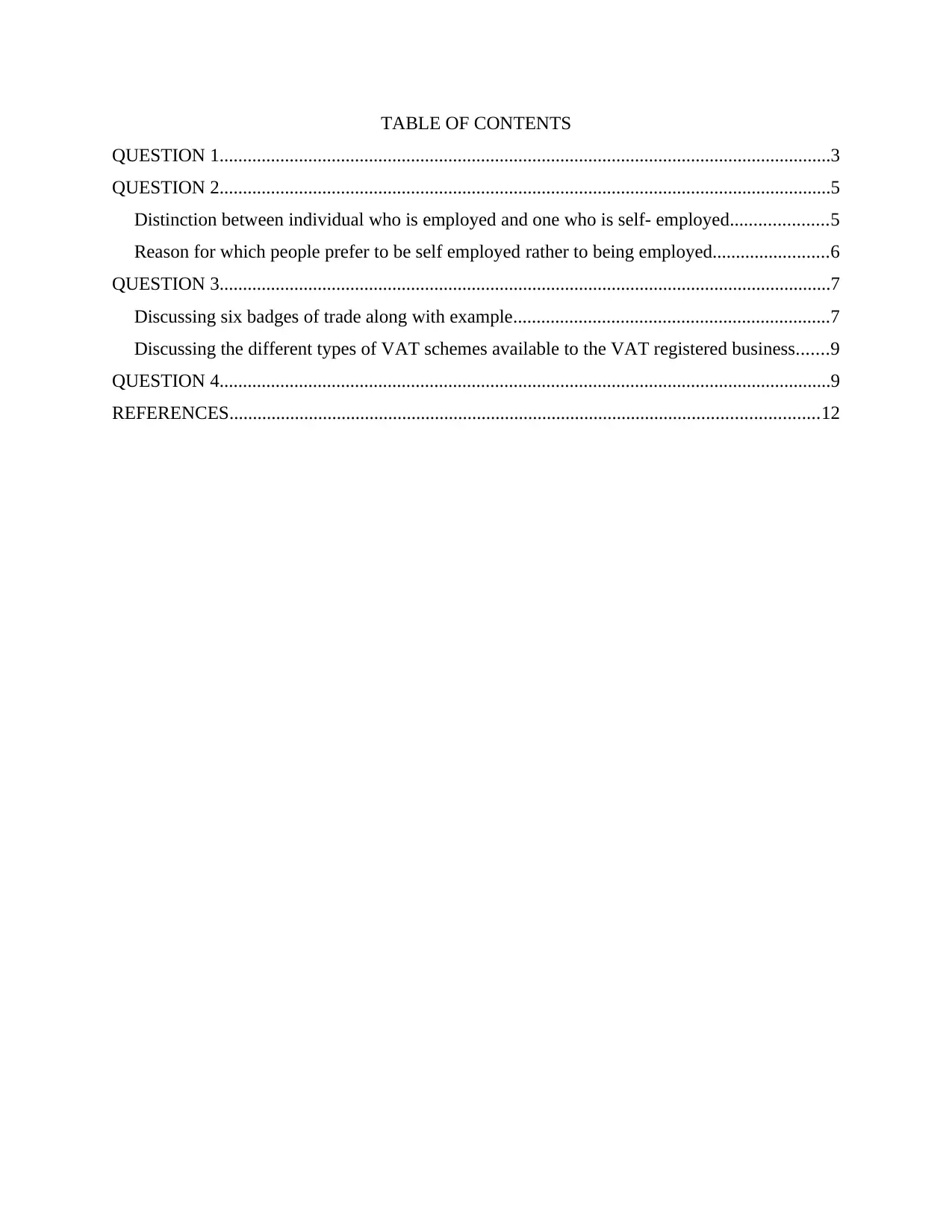
TABLE OF CONTENTS
QUESTION 1...................................................................................................................................3
QUESTION 2...................................................................................................................................5
Distinction between individual who is employed and one who is self- employed.....................5
Reason for which people prefer to be self employed rather to being employed.........................6
QUESTION 3...................................................................................................................................7
Discussing six badges of trade along with example....................................................................7
Discussing the different types of VAT schemes available to the VAT registered business.......9
QUESTION 4...................................................................................................................................9
REFERENCES..............................................................................................................................12
QUESTION 1...................................................................................................................................3
QUESTION 2...................................................................................................................................5
Distinction between individual who is employed and one who is self- employed.....................5
Reason for which people prefer to be self employed rather to being employed.........................6
QUESTION 3...................................................................................................................................7
Discussing six badges of trade along with example....................................................................7
Discussing the different types of VAT schemes available to the VAT registered business.......9
QUESTION 4...................................................................................................................................9
REFERENCES..............................................................................................................................12
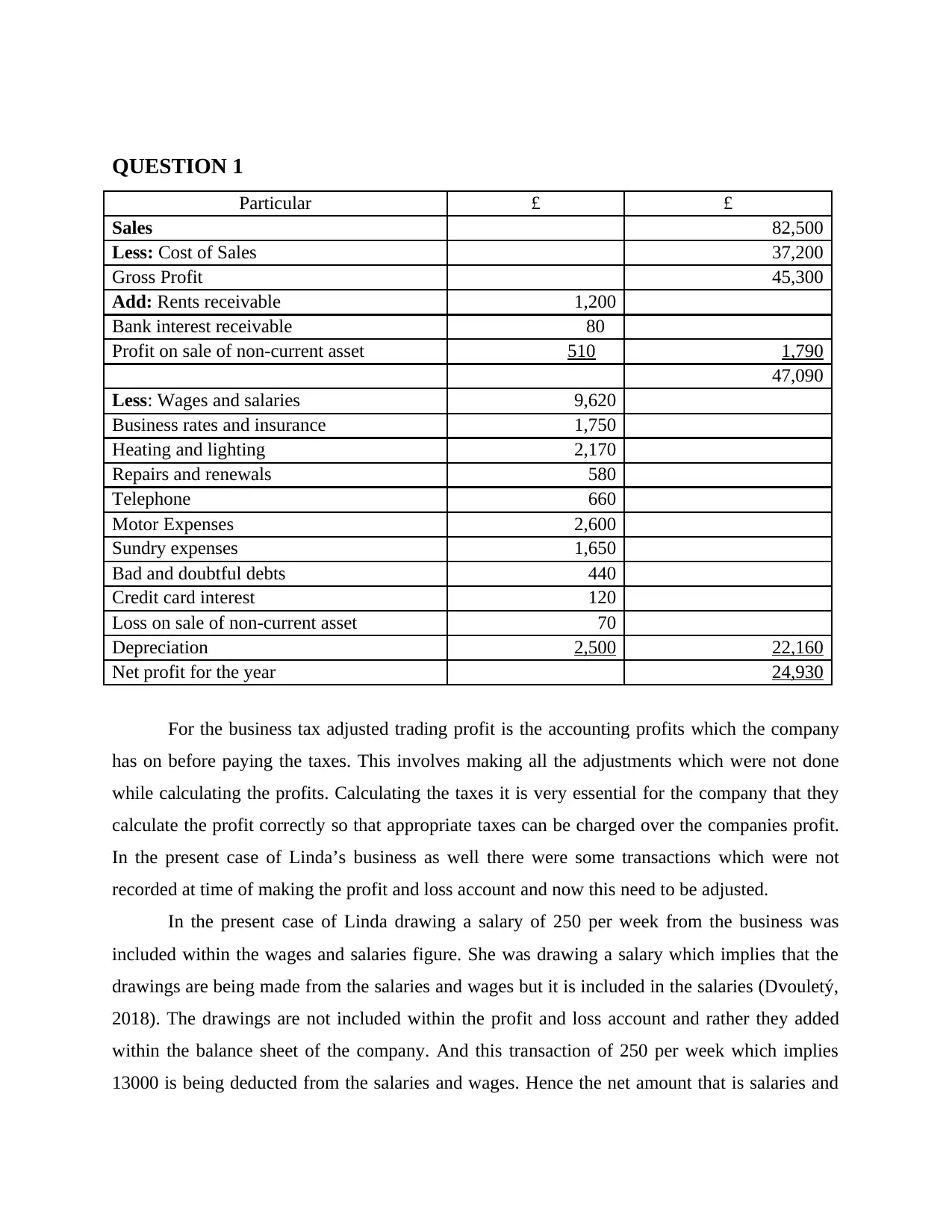
QUESTION 1
Particular £ £
Sales 82,500
Less: Cost of Sales 37,200
Gross Profit 45,300
Add: Rents receivable 1,200
Bank interest receivable 80
Profit on sale of non-current asset 510 1,790
47,090
Less: Wages and salaries 9,620
Business rates and insurance 1,750
Heating and lighting 2,170
Repairs and renewals 580
Telephone 660
Motor Expenses 2,600
Sundry expenses 1,650
Bad and doubtful debts 440
Credit card interest 120
Loss on sale of non-current asset 70
Depreciation 2,500 22,160
Net profit for the year 24,930
For the business tax adjusted trading profit is the accounting profits which the company
has on before paying the taxes. This involves making all the adjustments which were not done
while calculating the profits. Calculating the taxes it is very essential for the company that they
calculate the profit correctly so that appropriate taxes can be charged over the companies profit.
In the present case of Linda’s business as well there were some transactions which were not
recorded at time of making the profit and loss account and now this need to be adjusted.
In the present case of Linda drawing a salary of 250 per week from the business was
included within the wages and salaries figure. She was drawing a salary which implies that the
drawings are being made from the salaries and wages but it is included in the salaries (Dvouletý,
2018). The drawings are not included within the profit and loss account and rather they added
within the balance sheet of the company. And this transaction of 250 per week which implies
13000 is being deducted from the salaries and wages. Hence the net amount that is salaries and
Particular £ £
Sales 82,500
Less: Cost of Sales 37,200
Gross Profit 45,300
Add: Rents receivable 1,200
Bank interest receivable 80
Profit on sale of non-current asset 510 1,790
47,090
Less: Wages and salaries 9,620
Business rates and insurance 1,750
Heating and lighting 2,170
Repairs and renewals 580
Telephone 660
Motor Expenses 2,600
Sundry expenses 1,650
Bad and doubtful debts 440
Credit card interest 120
Loss on sale of non-current asset 70
Depreciation 2,500 22,160
Net profit for the year 24,930
For the business tax adjusted trading profit is the accounting profits which the company
has on before paying the taxes. This involves making all the adjustments which were not done
while calculating the profits. Calculating the taxes it is very essential for the company that they
calculate the profit correctly so that appropriate taxes can be charged over the companies profit.
In the present case of Linda’s business as well there were some transactions which were not
recorded at time of making the profit and loss account and now this need to be adjusted.
In the present case of Linda drawing a salary of 250 per week from the business was
included within the wages and salaries figure. She was drawing a salary which implies that the
drawings are being made from the salaries and wages but it is included in the salaries (Dvouletý,
2018). The drawings are not included within the profit and loss account and rather they added
within the balance sheet of the company. And this transaction of 250 per week which implies
13000 is being deducted from the salaries and wages. Hence the net amount that is salaries and
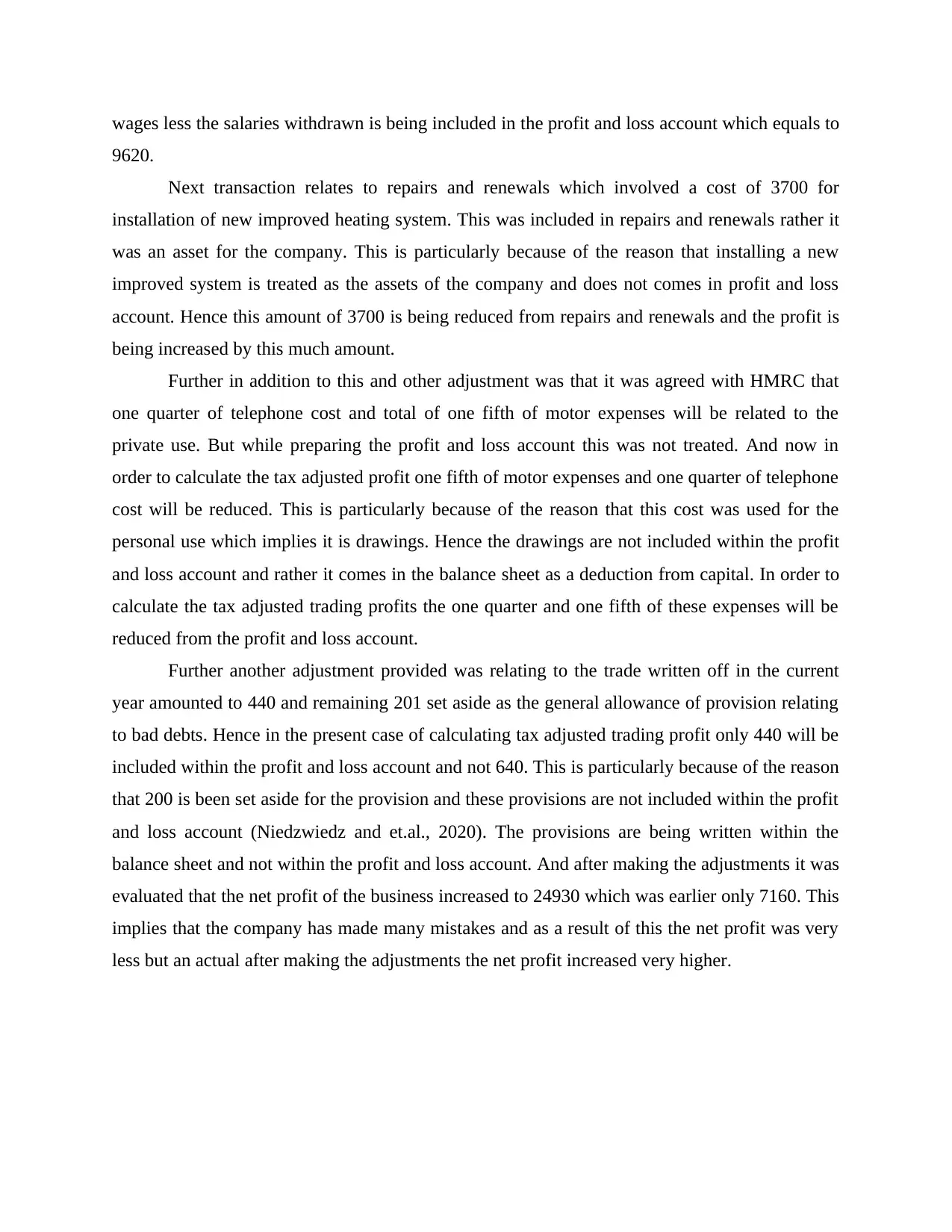
wages less the salaries withdrawn is being included in the profit and loss account which equals to
9620.
Next transaction relates to repairs and renewals which involved a cost of 3700 for
installation of new improved heating system. This was included in repairs and renewals rather it
was an asset for the company. This is particularly because of the reason that installing a new
improved system is treated as the assets of the company and does not comes in profit and loss
account. Hence this amount of 3700 is being reduced from repairs and renewals and the profit is
being increased by this much amount.
Further in addition to this and other adjustment was that it was agreed with HMRC that
one quarter of telephone cost and total of one fifth of motor expenses will be related to the
private use. But while preparing the profit and loss account this was not treated. And now in
order to calculate the tax adjusted profit one fifth of motor expenses and one quarter of telephone
cost will be reduced. This is particularly because of the reason that this cost was used for the
personal use which implies it is drawings. Hence the drawings are not included within the profit
and loss account and rather it comes in the balance sheet as a deduction from capital. In order to
calculate the tax adjusted trading profits the one quarter and one fifth of these expenses will be
reduced from the profit and loss account.
Further another adjustment provided was relating to the trade written off in the current
year amounted to 440 and remaining 201 set aside as the general allowance of provision relating
to bad debts. Hence in the present case of calculating tax adjusted trading profit only 440 will be
included within the profit and loss account and not 640. This is particularly because of the reason
that 200 is been set aside for the provision and these provisions are not included within the profit
and loss account (Niedzwiedz and et.al., 2020). The provisions are being written within the
balance sheet and not within the profit and loss account. And after making the adjustments it was
evaluated that the net profit of the business increased to 24930 which was earlier only 7160. This
implies that the company has made many mistakes and as a result of this the net profit was very
less but an actual after making the adjustments the net profit increased very higher.
9620.
Next transaction relates to repairs and renewals which involved a cost of 3700 for
installation of new improved heating system. This was included in repairs and renewals rather it
was an asset for the company. This is particularly because of the reason that installing a new
improved system is treated as the assets of the company and does not comes in profit and loss
account. Hence this amount of 3700 is being reduced from repairs and renewals and the profit is
being increased by this much amount.
Further in addition to this and other adjustment was that it was agreed with HMRC that
one quarter of telephone cost and total of one fifth of motor expenses will be related to the
private use. But while preparing the profit and loss account this was not treated. And now in
order to calculate the tax adjusted profit one fifth of motor expenses and one quarter of telephone
cost will be reduced. This is particularly because of the reason that this cost was used for the
personal use which implies it is drawings. Hence the drawings are not included within the profit
and loss account and rather it comes in the balance sheet as a deduction from capital. In order to
calculate the tax adjusted trading profits the one quarter and one fifth of these expenses will be
reduced from the profit and loss account.
Further another adjustment provided was relating to the trade written off in the current
year amounted to 440 and remaining 201 set aside as the general allowance of provision relating
to bad debts. Hence in the present case of calculating tax adjusted trading profit only 440 will be
included within the profit and loss account and not 640. This is particularly because of the reason
that 200 is been set aside for the provision and these provisions are not included within the profit
and loss account (Niedzwiedz and et.al., 2020). The provisions are being written within the
balance sheet and not within the profit and loss account. And after making the adjustments it was
evaluated that the net profit of the business increased to 24930 which was earlier only 7160. This
implies that the company has made many mistakes and as a result of this the net profit was very
less but an actual after making the adjustments the net profit increased very higher.
Secure Best Marks with AI Grader
Need help grading? Try our AI Grader for instant feedback on your assignments.
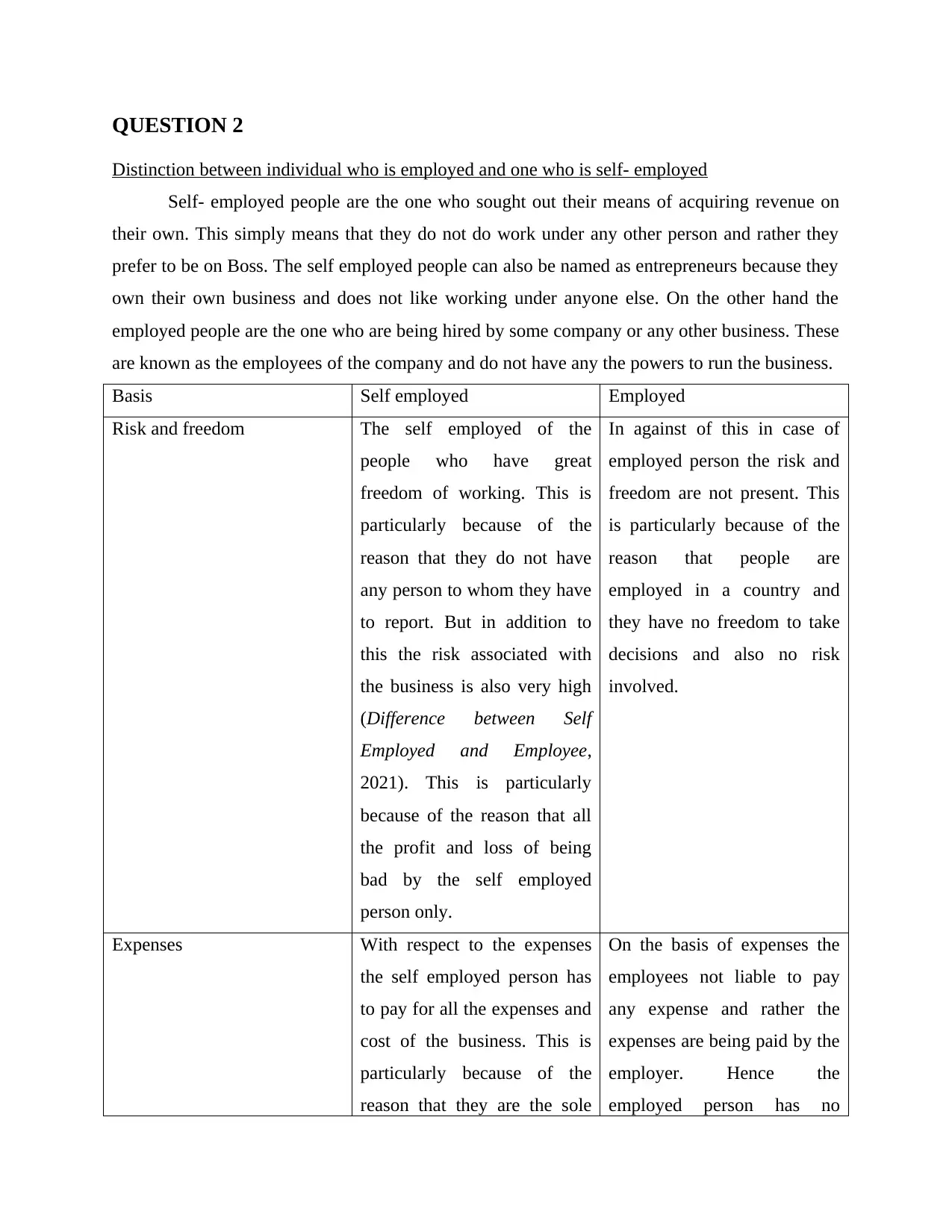
QUESTION 2
Distinction between individual who is employed and one who is self- employed
Self- employed people are the one who sought out their means of acquiring revenue on
their own. This simply means that they do not do work under any other person and rather they
prefer to be on Boss. The self employed people can also be named as entrepreneurs because they
own their own business and does not like working under anyone else. On the other hand the
employed people are the one who are being hired by some company or any other business. These
are known as the employees of the company and do not have any the powers to run the business.
Basis Self employed Employed
Risk and freedom The self employed of the
people who have great
freedom of working. This is
particularly because of the
reason that they do not have
any person to whom they have
to report. But in addition to
this the risk associated with
the business is also very high
(Difference between Self
Employed and Employee,
2021). This is particularly
because of the reason that all
the profit and loss of being
bad by the self employed
person only.
In against of this in case of
employed person the risk and
freedom are not present. This
is particularly because of the
reason that people are
employed in a country and
they have no freedom to take
decisions and also no risk
involved.
Expenses With respect to the expenses
the self employed person has
to pay for all the expenses and
cost of the business. This is
particularly because of the
reason that they are the sole
On the basis of expenses the
employees not liable to pay
any expense and rather the
expenses are being paid by the
employer. Hence the
employed person has no
Distinction between individual who is employed and one who is self- employed
Self- employed people are the one who sought out their means of acquiring revenue on
their own. This simply means that they do not do work under any other person and rather they
prefer to be on Boss. The self employed people can also be named as entrepreneurs because they
own their own business and does not like working under anyone else. On the other hand the
employed people are the one who are being hired by some company or any other business. These
are known as the employees of the company and do not have any the powers to run the business.
Basis Self employed Employed
Risk and freedom The self employed of the
people who have great
freedom of working. This is
particularly because of the
reason that they do not have
any person to whom they have
to report. But in addition to
this the risk associated with
the business is also very high
(Difference between Self
Employed and Employee,
2021). This is particularly
because of the reason that all
the profit and loss of being
bad by the self employed
person only.
In against of this in case of
employed person the risk and
freedom are not present. This
is particularly because of the
reason that people are
employed in a country and
they have no freedom to take
decisions and also no risk
involved.
Expenses With respect to the expenses
the self employed person has
to pay for all the expenses and
cost of the business. This is
particularly because of the
reason that they are the sole
On the basis of expenses the
employees not liable to pay
any expense and rather the
expenses are being paid by the
employer. Hence the
employed person has no
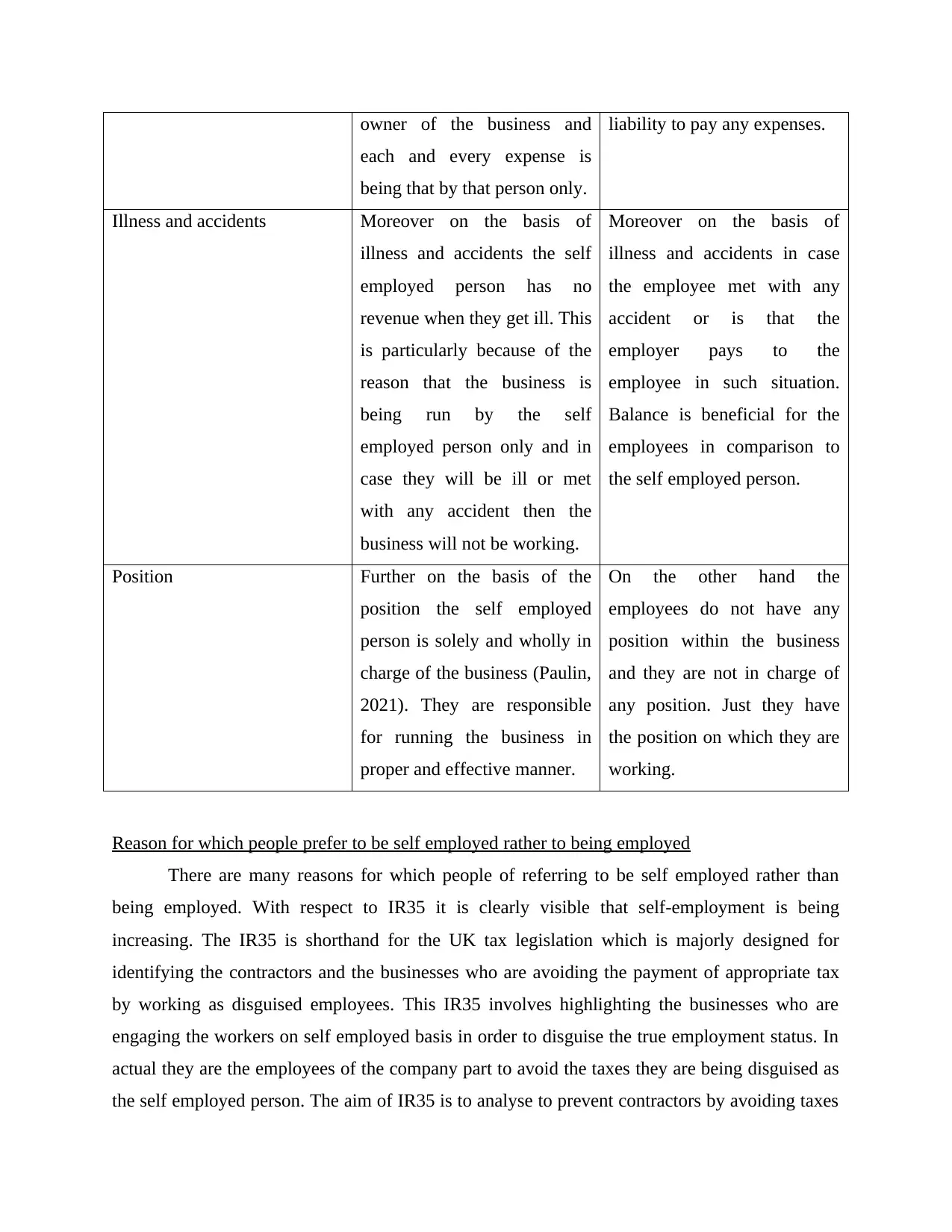
owner of the business and
each and every expense is
being that by that person only.
liability to pay any expenses.
Illness and accidents Moreover on the basis of
illness and accidents the self
employed person has no
revenue when they get ill. This
is particularly because of the
reason that the business is
being run by the self
employed person only and in
case they will be ill or met
with any accident then the
business will not be working.
Moreover on the basis of
illness and accidents in case
the employee met with any
accident or is that the
employer pays to the
employee in such situation.
Balance is beneficial for the
employees in comparison to
the self employed person.
Position Further on the basis of the
position the self employed
person is solely and wholly in
charge of the business (Paulin,
2021). They are responsible
for running the business in
proper and effective manner.
On the other hand the
employees do not have any
position within the business
and they are not in charge of
any position. Just they have
the position on which they are
working.
Reason for which people prefer to be self employed rather to being employed
There are many reasons for which people of referring to be self employed rather than
being employed. With respect to IR35 it is clearly visible that self-employment is being
increasing. The IR35 is shorthand for the UK tax legislation which is majorly designed for
identifying the contractors and the businesses who are avoiding the payment of appropriate tax
by working as disguised employees. This IR35 involves highlighting the businesses who are
engaging the workers on self employed basis in order to disguise the true employment status. In
actual they are the employees of the company part to avoid the taxes they are being disguised as
the self employed person. The aim of IR35 is to analyse to prevent contractors by avoiding taxes
each and every expense is
being that by that person only.
liability to pay any expenses.
Illness and accidents Moreover on the basis of
illness and accidents the self
employed person has no
revenue when they get ill. This
is particularly because of the
reason that the business is
being run by the self
employed person only and in
case they will be ill or met
with any accident then the
business will not be working.
Moreover on the basis of
illness and accidents in case
the employee met with any
accident or is that the
employer pays to the
employee in such situation.
Balance is beneficial for the
employees in comparison to
the self employed person.
Position Further on the basis of the
position the self employed
person is solely and wholly in
charge of the business (Paulin,
2021). They are responsible
for running the business in
proper and effective manner.
On the other hand the
employees do not have any
position within the business
and they are not in charge of
any position. Just they have
the position on which they are
working.
Reason for which people prefer to be self employed rather to being employed
There are many reasons for which people of referring to be self employed rather than
being employed. With respect to IR35 it is clearly visible that self-employment is being
increasing. The IR35 is shorthand for the UK tax legislation which is majorly designed for
identifying the contractors and the businesses who are avoiding the payment of appropriate tax
by working as disguised employees. This IR35 involves highlighting the businesses who are
engaging the workers on self employed basis in order to disguise the true employment status. In
actual they are the employees of the company part to avoid the taxes they are being disguised as
the self employed person. The aim of IR35 is to analyse to prevent contractors by avoiding taxes
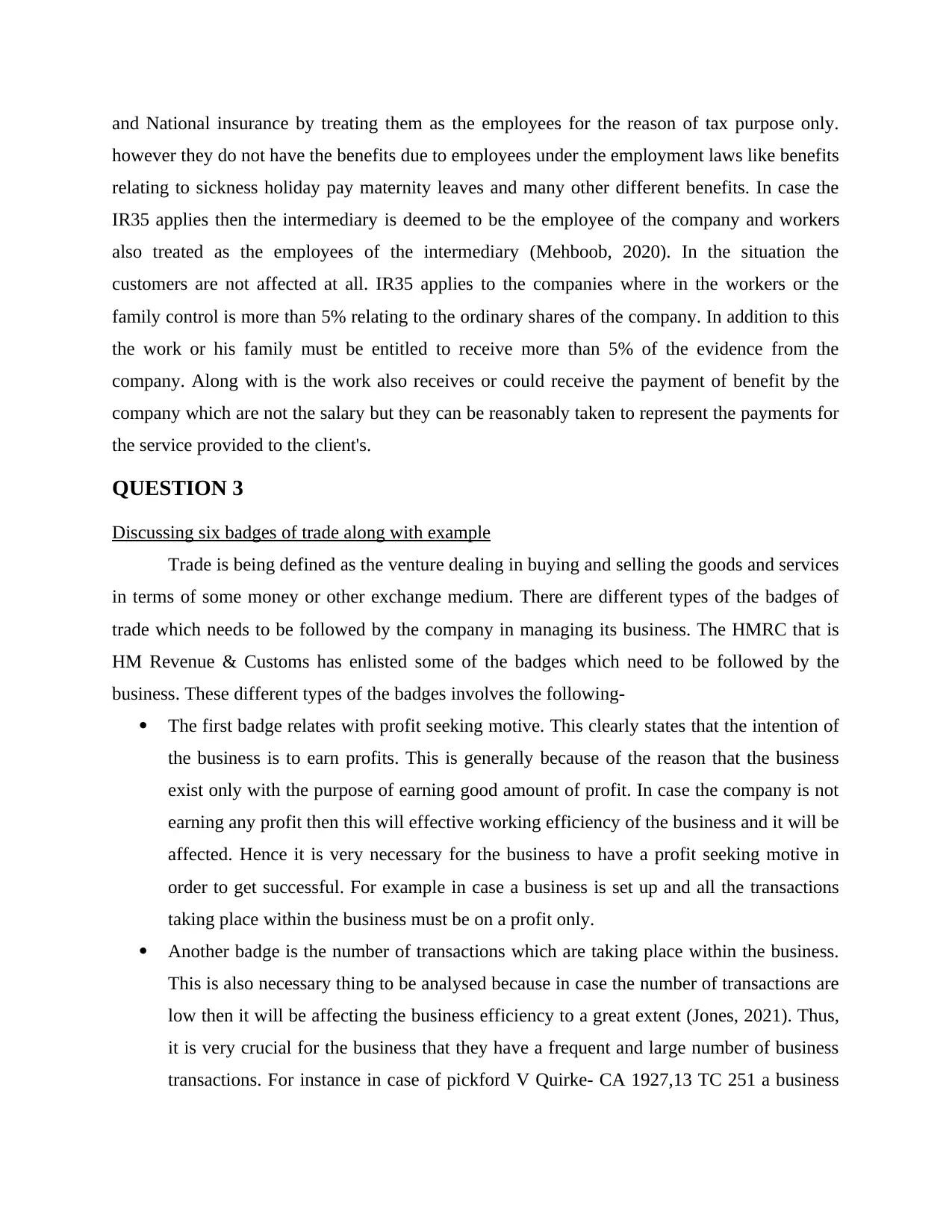
and National insurance by treating them as the employees for the reason of tax purpose only.
however they do not have the benefits due to employees under the employment laws like benefits
relating to sickness holiday pay maternity leaves and many other different benefits. In case the
IR35 applies then the intermediary is deemed to be the employee of the company and workers
also treated as the employees of the intermediary (Mehboob, 2020). In the situation the
customers are not affected at all. IR35 applies to the companies where in the workers or the
family control is more than 5% relating to the ordinary shares of the company. In addition to this
the work or his family must be entitled to receive more than 5% of the evidence from the
company. Along with is the work also receives or could receive the payment of benefit by the
company which are not the salary but they can be reasonably taken to represent the payments for
the service provided to the client's.
QUESTION 3
Discussing six badges of trade along with example
Trade is being defined as the venture dealing in buying and selling the goods and services
in terms of some money or other exchange medium. There are different types of the badges of
trade which needs to be followed by the company in managing its business. The HMRC that is
HM Revenue & Customs has enlisted some of the badges which need to be followed by the
business. These different types of the badges involves the following-
The first badge relates with profit seeking motive. This clearly states that the intention of
the business is to earn profits. This is generally because of the reason that the business
exist only with the purpose of earning good amount of profit. In case the company is not
earning any profit then this will effective working efficiency of the business and it will be
affected. Hence it is very necessary for the business to have a profit seeking motive in
order to get successful. For example in case a business is set up and all the transactions
taking place within the business must be on a profit only.
Another badge is the number of transactions which are taking place within the business.
This is also necessary thing to be analysed because in case the number of transactions are
low then it will be affecting the business efficiency to a great extent (Jones, 2021). Thus,
it is very crucial for the business that they have a frequent and large number of business
transactions. For instance in case of pickford V Quirke- CA 1927,13 TC 251 a business
however they do not have the benefits due to employees under the employment laws like benefits
relating to sickness holiday pay maternity leaves and many other different benefits. In case the
IR35 applies then the intermediary is deemed to be the employee of the company and workers
also treated as the employees of the intermediary (Mehboob, 2020). In the situation the
customers are not affected at all. IR35 applies to the companies where in the workers or the
family control is more than 5% relating to the ordinary shares of the company. In addition to this
the work or his family must be entitled to receive more than 5% of the evidence from the
company. Along with is the work also receives or could receive the payment of benefit by the
company which are not the salary but they can be reasonably taken to represent the payments for
the service provided to the client's.
QUESTION 3
Discussing six badges of trade along with example
Trade is being defined as the venture dealing in buying and selling the goods and services
in terms of some money or other exchange medium. There are different types of the badges of
trade which needs to be followed by the company in managing its business. The HMRC that is
HM Revenue & Customs has enlisted some of the badges which need to be followed by the
business. These different types of the badges involves the following-
The first badge relates with profit seeking motive. This clearly states that the intention of
the business is to earn profits. This is generally because of the reason that the business
exist only with the purpose of earning good amount of profit. In case the company is not
earning any profit then this will effective working efficiency of the business and it will be
affected. Hence it is very necessary for the business to have a profit seeking motive in
order to get successful. For example in case a business is set up and all the transactions
taking place within the business must be on a profit only.
Another badge is the number of transactions which are taking place within the business.
This is also necessary thing to be analysed because in case the number of transactions are
low then it will be affecting the business efficiency to a great extent (Jones, 2021). Thus,
it is very crucial for the business that they have a frequent and large number of business
transactions. For instance in case of pickford V Quirke- CA 1927,13 TC 251 a business
Paraphrase This Document
Need a fresh take? Get an instant paraphrase of this document with our AI Paraphraser
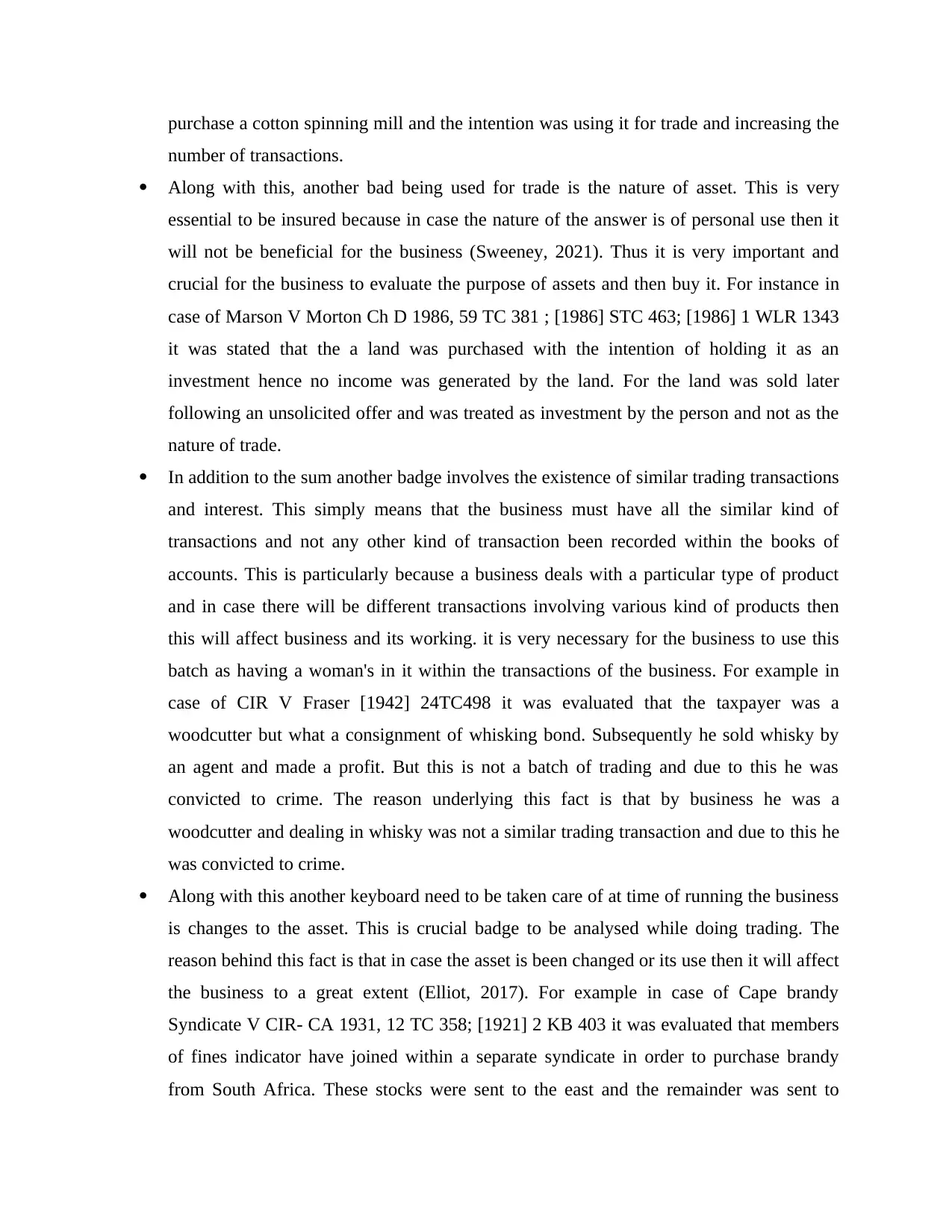
purchase a cotton spinning mill and the intention was using it for trade and increasing the
number of transactions.
Along with this, another bad being used for trade is the nature of asset. This is very
essential to be insured because in case the nature of the answer is of personal use then it
will not be beneficial for the business (Sweeney, 2021). Thus it is very important and
crucial for the business to evaluate the purpose of assets and then buy it. For instance in
case of Marson V Morton Ch D 1986, 59 TC 381 ; [1986] STC 463; [1986] 1 WLR 1343
it was stated that the a land was purchased with the intention of holding it as an
investment hence no income was generated by the land. For the land was sold later
following an unsolicited offer and was treated as investment by the person and not as the
nature of trade.
In addition to the sum another badge involves the existence of similar trading transactions
and interest. This simply means that the business must have all the similar kind of
transactions and not any other kind of transaction been recorded within the books of
accounts. This is particularly because a business deals with a particular type of product
and in case there will be different transactions involving various kind of products then
this will affect business and its working. it is very necessary for the business to use this
batch as having a woman's in it within the transactions of the business. For example in
case of CIR V Fraser [1942] 24TC498 it was evaluated that the taxpayer was a
woodcutter but what a consignment of whisking bond. Subsequently he sold whisky by
an agent and made a profit. But this is not a batch of trading and due to this he was
convicted to crime. The reason underlying this fact is that by business he was a
woodcutter and dealing in whisky was not a similar trading transaction and due to this he
was convicted to crime.
Along with this another keyboard need to be taken care of at time of running the business
is changes to the asset. This is crucial badge to be analysed while doing trading. The
reason behind this fact is that in case the asset is been changed or its use then it will affect
the business to a great extent (Elliot, 2017). For example in case of Cape brandy
Syndicate V CIR- CA 1931, 12 TC 358; [1921] 2 KB 403 it was evaluated that members
of fines indicator have joined within a separate syndicate in order to purchase brandy
from South Africa. These stocks were sent to the east and the remainder was sent to
number of transactions.
Along with this, another bad being used for trade is the nature of asset. This is very
essential to be insured because in case the nature of the answer is of personal use then it
will not be beneficial for the business (Sweeney, 2021). Thus it is very important and
crucial for the business to evaluate the purpose of assets and then buy it. For instance in
case of Marson V Morton Ch D 1986, 59 TC 381 ; [1986] STC 463; [1986] 1 WLR 1343
it was stated that the a land was purchased with the intention of holding it as an
investment hence no income was generated by the land. For the land was sold later
following an unsolicited offer and was treated as investment by the person and not as the
nature of trade.
In addition to the sum another badge involves the existence of similar trading transactions
and interest. This simply means that the business must have all the similar kind of
transactions and not any other kind of transaction been recorded within the books of
accounts. This is particularly because a business deals with a particular type of product
and in case there will be different transactions involving various kind of products then
this will affect business and its working. it is very necessary for the business to use this
batch as having a woman's in it within the transactions of the business. For example in
case of CIR V Fraser [1942] 24TC498 it was evaluated that the taxpayer was a
woodcutter but what a consignment of whisking bond. Subsequently he sold whisky by
an agent and made a profit. But this is not a batch of trading and due to this he was
convicted to crime. The reason underlying this fact is that by business he was a
woodcutter and dealing in whisky was not a similar trading transaction and due to this he
was convicted to crime.
Along with this another keyboard need to be taken care of at time of running the business
is changes to the asset. This is crucial badge to be analysed while doing trading. The
reason behind this fact is that in case the asset is been changed or its use then it will affect
the business to a great extent (Elliot, 2017). For example in case of Cape brandy
Syndicate V CIR- CA 1931, 12 TC 358; [1921] 2 KB 403 it was evaluated that members
of fines indicator have joined within a separate syndicate in order to purchase brandy
from South Africa. These stocks were sent to the east and the remainder was sent to
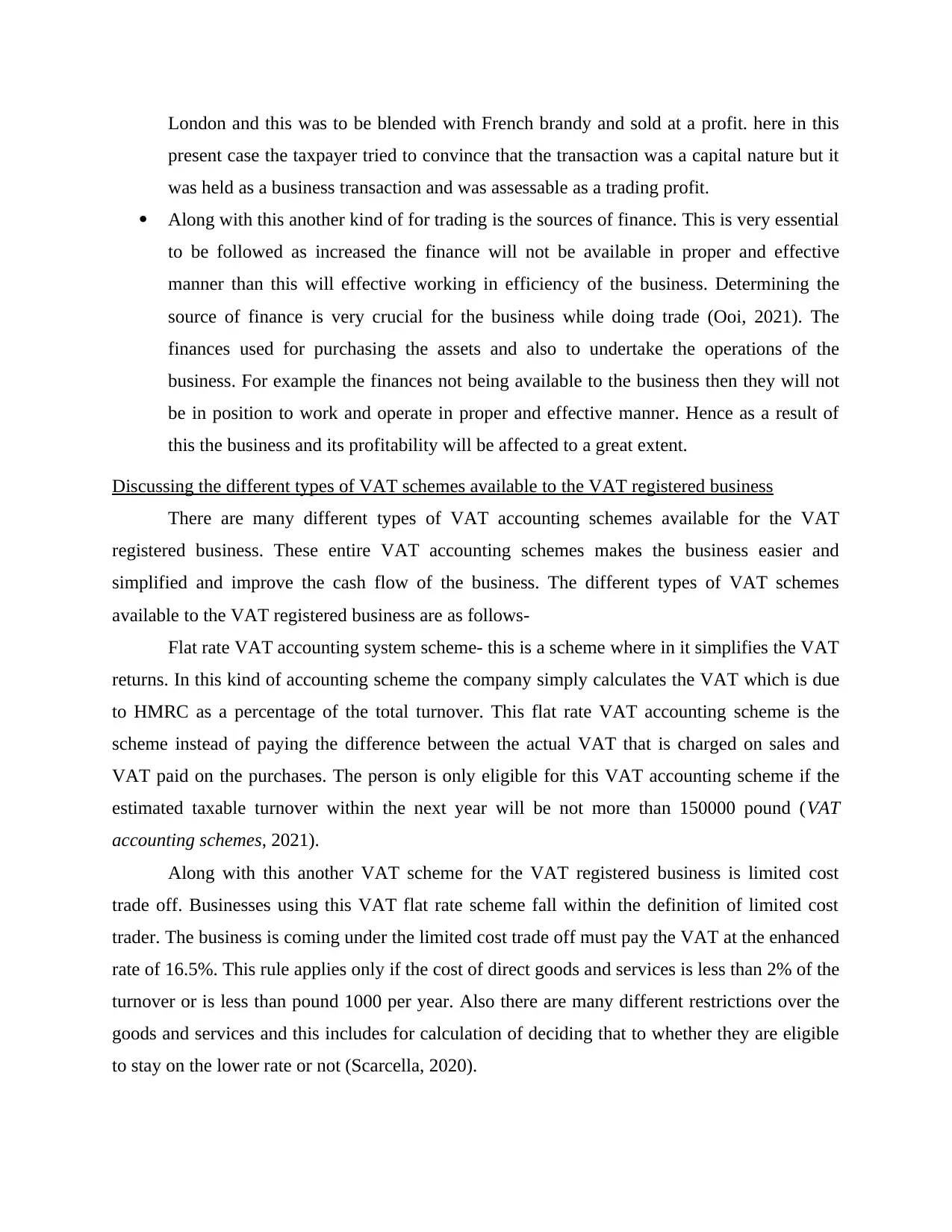
London and this was to be blended with French brandy and sold at a profit. here in this
present case the taxpayer tried to convince that the transaction was a capital nature but it
was held as a business transaction and was assessable as a trading profit.
Along with this another kind of for trading is the sources of finance. This is very essential
to be followed as increased the finance will not be available in proper and effective
manner than this will effective working in efficiency of the business. Determining the
source of finance is very crucial for the business while doing trade (Ooi, 2021). The
finances used for purchasing the assets and also to undertake the operations of the
business. For example the finances not being available to the business then they will not
be in position to work and operate in proper and effective manner. Hence as a result of
this the business and its profitability will be affected to a great extent.
Discussing the different types of VAT schemes available to the VAT registered business
There are many different types of VAT accounting schemes available for the VAT
registered business. These entire VAT accounting schemes makes the business easier and
simplified and improve the cash flow of the business. The different types of VAT schemes
available to the VAT registered business are as follows-
Flat rate VAT accounting system scheme- this is a scheme where in it simplifies the VAT
returns. In this kind of accounting scheme the company simply calculates the VAT which is due
to HMRC as a percentage of the total turnover. This flat rate VAT accounting scheme is the
scheme instead of paying the difference between the actual VAT that is charged on sales and
VAT paid on the purchases. The person is only eligible for this VAT accounting scheme if the
estimated taxable turnover within the next year will be not more than 150000 pound (VAT
accounting schemes, 2021).
Along with this another VAT scheme for the VAT registered business is limited cost
trade off. Businesses using this VAT flat rate scheme fall within the definition of limited cost
trader. The business is coming under the limited cost trade off must pay the VAT at the enhanced
rate of 16.5%. This rule applies only if the cost of direct goods and services is less than 2% of the
turnover or is less than pound 1000 per year. Also there are many different restrictions over the
goods and services and this includes for calculation of deciding that to whether they are eligible
to stay on the lower rate or not (Scarcella, 2020).
present case the taxpayer tried to convince that the transaction was a capital nature but it
was held as a business transaction and was assessable as a trading profit.
Along with this another kind of for trading is the sources of finance. This is very essential
to be followed as increased the finance will not be available in proper and effective
manner than this will effective working in efficiency of the business. Determining the
source of finance is very crucial for the business while doing trade (Ooi, 2021). The
finances used for purchasing the assets and also to undertake the operations of the
business. For example the finances not being available to the business then they will not
be in position to work and operate in proper and effective manner. Hence as a result of
this the business and its profitability will be affected to a great extent.
Discussing the different types of VAT schemes available to the VAT registered business
There are many different types of VAT accounting schemes available for the VAT
registered business. These entire VAT accounting schemes makes the business easier and
simplified and improve the cash flow of the business. The different types of VAT schemes
available to the VAT registered business are as follows-
Flat rate VAT accounting system scheme- this is a scheme where in it simplifies the VAT
returns. In this kind of accounting scheme the company simply calculates the VAT which is due
to HMRC as a percentage of the total turnover. This flat rate VAT accounting scheme is the
scheme instead of paying the difference between the actual VAT that is charged on sales and
VAT paid on the purchases. The person is only eligible for this VAT accounting scheme if the
estimated taxable turnover within the next year will be not more than 150000 pound (VAT
accounting schemes, 2021).
Along with this another VAT scheme for the VAT registered business is limited cost
trade off. Businesses using this VAT flat rate scheme fall within the definition of limited cost
trader. The business is coming under the limited cost trade off must pay the VAT at the enhanced
rate of 16.5%. This rule applies only if the cost of direct goods and services is less than 2% of the
turnover or is less than pound 1000 per year. Also there are many different restrictions over the
goods and services and this includes for calculation of deciding that to whether they are eligible
to stay on the lower rate or not (Scarcella, 2020).
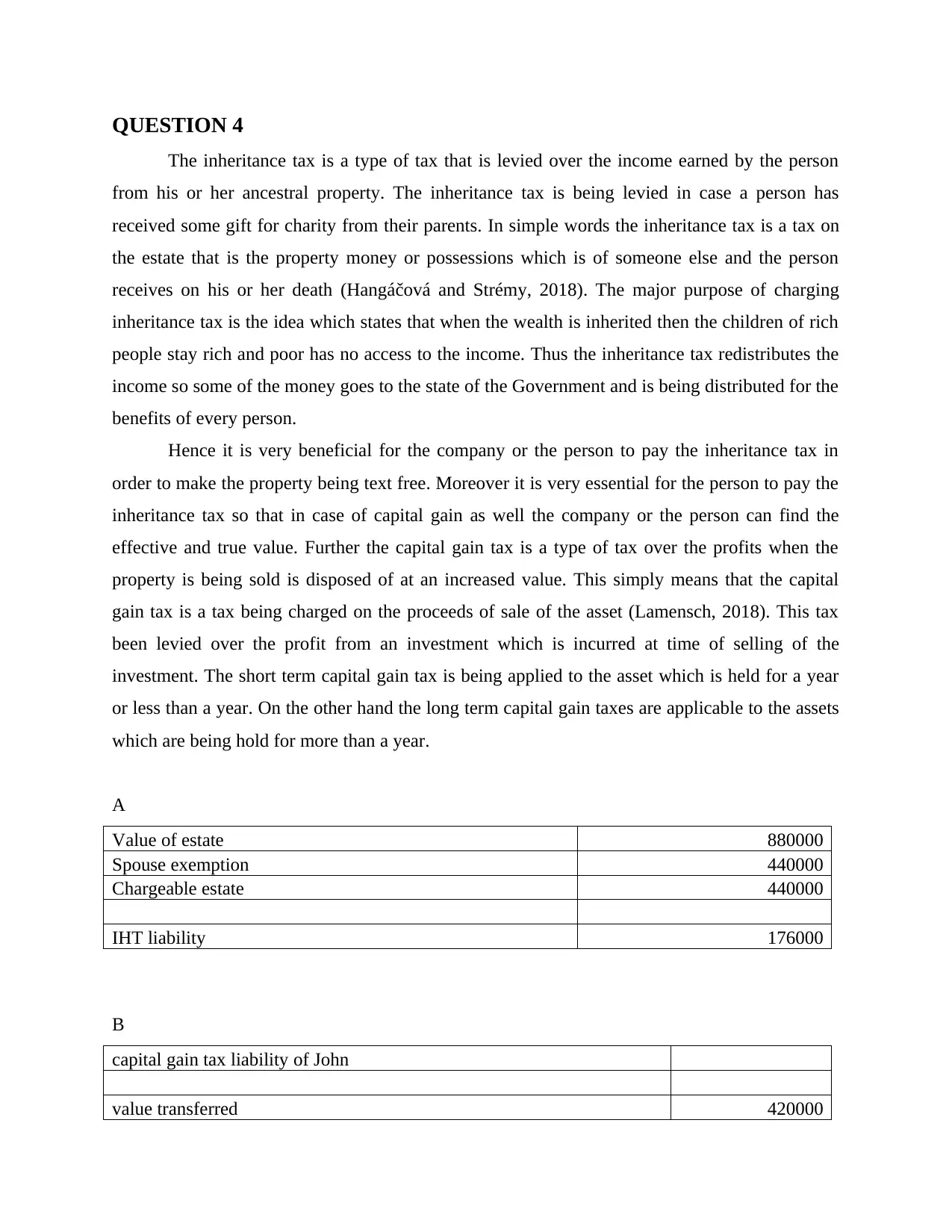
QUESTION 4
The inheritance tax is a type of tax that is levied over the income earned by the person
from his or her ancestral property. The inheritance tax is being levied in case a person has
received some gift for charity from their parents. In simple words the inheritance tax is a tax on
the estate that is the property money or possessions which is of someone else and the person
receives on his or her death (Hangáčová and Strémy, 2018). The major purpose of charging
inheritance tax is the idea which states that when the wealth is inherited then the children of rich
people stay rich and poor has no access to the income. Thus the inheritance tax redistributes the
income so some of the money goes to the state of the Government and is being distributed for the
benefits of every person.
Hence it is very beneficial for the company or the person to pay the inheritance tax in
order to make the property being text free. Moreover it is very essential for the person to pay the
inheritance tax so that in case of capital gain as well the company or the person can find the
effective and true value. Further the capital gain tax is a type of tax over the profits when the
property is being sold is disposed of at an increased value. This simply means that the capital
gain tax is a tax being charged on the proceeds of sale of the asset (Lamensch, 2018). This tax
been levied over the profit from an investment which is incurred at time of selling of the
investment. The short term capital gain tax is being applied to the asset which is held for a year
or less than a year. On the other hand the long term capital gain taxes are applicable to the assets
which are being hold for more than a year.
A
Value of estate 880000
Spouse exemption 440000
Chargeable estate 440000
IHT liability 176000
B
capital gain tax liability of John
value transferred 420000
The inheritance tax is a type of tax that is levied over the income earned by the person
from his or her ancestral property. The inheritance tax is being levied in case a person has
received some gift for charity from their parents. In simple words the inheritance tax is a tax on
the estate that is the property money or possessions which is of someone else and the person
receives on his or her death (Hangáčová and Strémy, 2018). The major purpose of charging
inheritance tax is the idea which states that when the wealth is inherited then the children of rich
people stay rich and poor has no access to the income. Thus the inheritance tax redistributes the
income so some of the money goes to the state of the Government and is being distributed for the
benefits of every person.
Hence it is very beneficial for the company or the person to pay the inheritance tax in
order to make the property being text free. Moreover it is very essential for the person to pay the
inheritance tax so that in case of capital gain as well the company or the person can find the
effective and true value. Further the capital gain tax is a type of tax over the profits when the
property is being sold is disposed of at an increased value. This simply means that the capital
gain tax is a tax being charged on the proceeds of sale of the asset (Lamensch, 2018). This tax
been levied over the profit from an investment which is incurred at time of selling of the
investment. The short term capital gain tax is being applied to the asset which is held for a year
or less than a year. On the other hand the long term capital gain taxes are applicable to the assets
which are being hold for more than a year.
A
Value of estate 880000
Spouse exemption 440000
Chargeable estate 440000
IHT liability 176000
B
capital gain tax liability of John
value transferred 420000
Secure Best Marks with AI Grader
Need help grading? Try our AI Grader for instant feedback on your assignments.
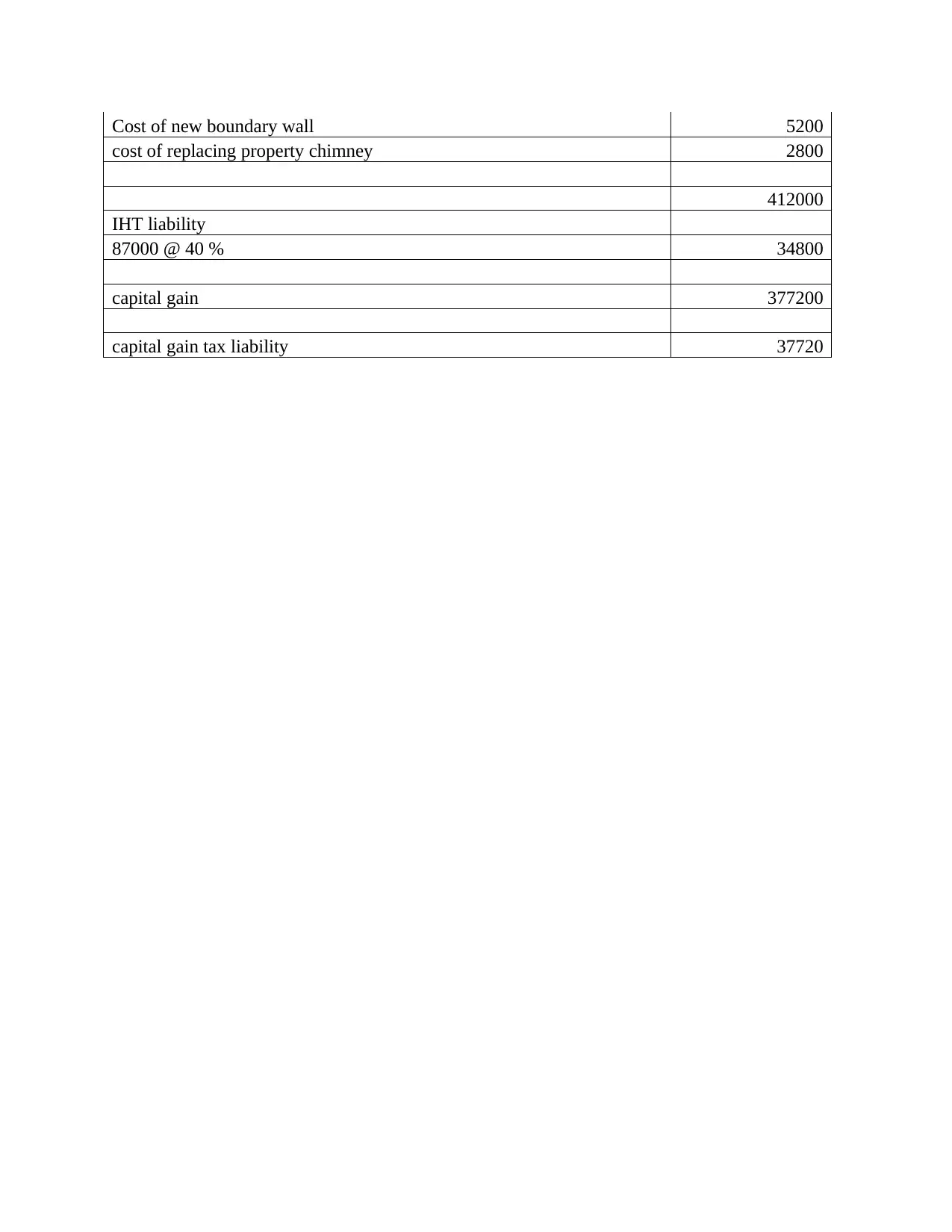
Cost of new boundary wall 5200
cost of replacing property chimney 2800
412000
IHT liability
87000 @ 40 % 34800
capital gain 377200
capital gain tax liability 37720
cost of replacing property chimney 2800
412000
IHT liability
87000 @ 40 % 34800
capital gain 377200
capital gain tax liability 37720
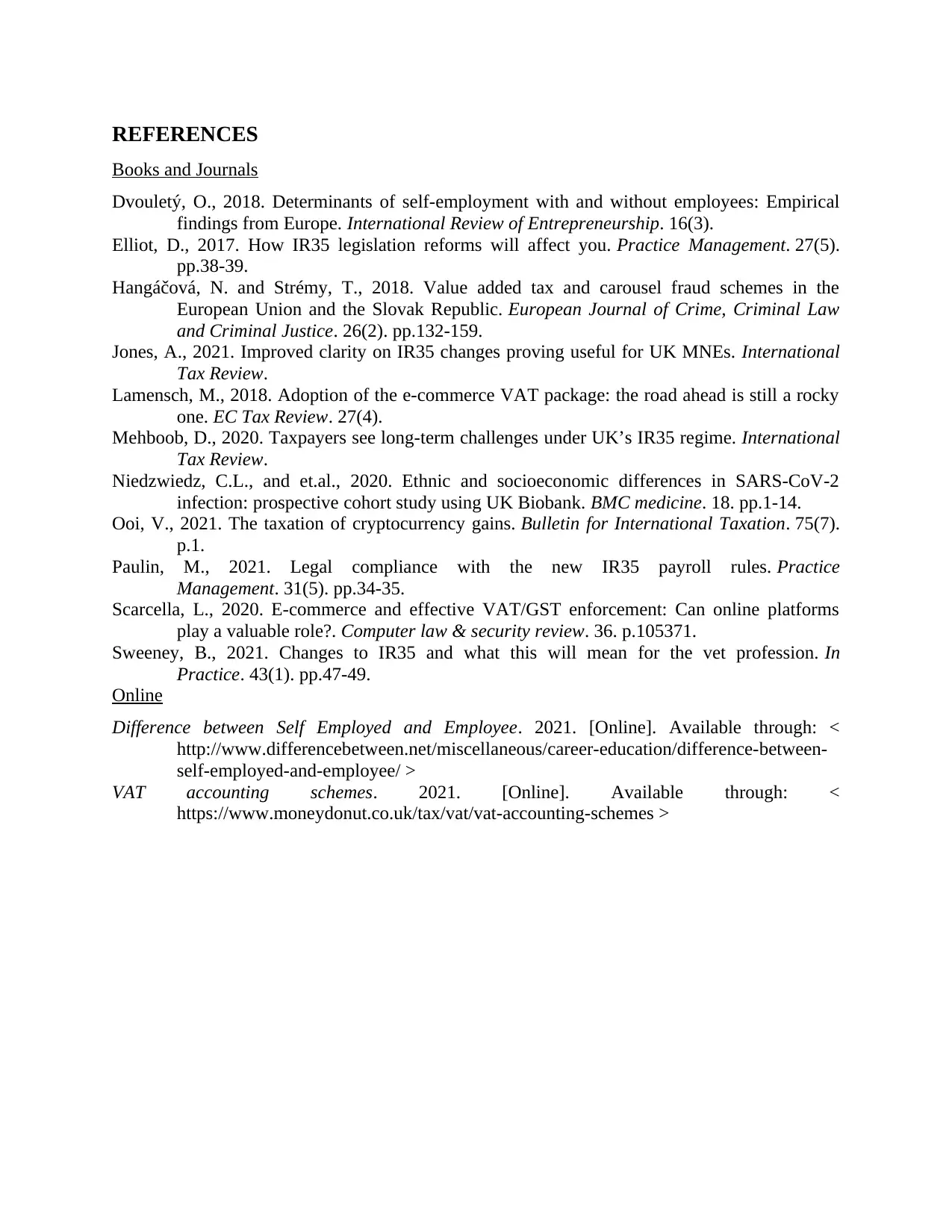
REFERENCES
Books and Journals
Dvouletý, O., 2018. Determinants of self-employment with and without employees: Empirical
findings from Europe. International Review of Entrepreneurship. 16(3).
Elliot, D., 2017. How IR35 legislation reforms will affect you. Practice Management. 27(5).
pp.38-39.
Hangáčová, N. and Strémy, T., 2018. Value added tax and carousel fraud schemes in the
European Union and the Slovak Republic. European Journal of Crime, Criminal Law
and Criminal Justice. 26(2). pp.132-159.
Jones, A., 2021. Improved clarity on IR35 changes proving useful for UK MNEs. International
Tax Review.
Lamensch, M., 2018. Adoption of the e-commerce VAT package: the road ahead is still a rocky
one. EC Tax Review. 27(4).
Mehboob, D., 2020. Taxpayers see long-term challenges under UK’s IR35 regime. International
Tax Review.
Niedzwiedz, C.L., and et.al., 2020. Ethnic and socioeconomic differences in SARS-CoV-2
infection: prospective cohort study using UK Biobank. BMC medicine. 18. pp.1-14.
Ooi, V., 2021. The taxation of cryptocurrency gains. Bulletin for International Taxation. 75(7).
p.1.
Paulin, M., 2021. Legal compliance with the new IR35 payroll rules. Practice
Management. 31(5). pp.34-35.
Scarcella, L., 2020. E-commerce and effective VAT/GST enforcement: Can online platforms
play a valuable role?. Computer law & security review. 36. p.105371.
Sweeney, B., 2021. Changes to IR35 and what this will mean for the vet profession. In
Practice. 43(1). pp.47-49.
Online
Difference between Self Employed and Employee. 2021. [Online]. Available through: <
http://www.differencebetween.net/miscellaneous/career-education/difference-between-
self-employed-and-employee/ >
VAT accounting schemes. 2021. [Online]. Available through: <
https://www.moneydonut.co.uk/tax/vat/vat-accounting-schemes >
Books and Journals
Dvouletý, O., 2018. Determinants of self-employment with and without employees: Empirical
findings from Europe. International Review of Entrepreneurship. 16(3).
Elliot, D., 2017. How IR35 legislation reforms will affect you. Practice Management. 27(5).
pp.38-39.
Hangáčová, N. and Strémy, T., 2018. Value added tax and carousel fraud schemes in the
European Union and the Slovak Republic. European Journal of Crime, Criminal Law
and Criminal Justice. 26(2). pp.132-159.
Jones, A., 2021. Improved clarity on IR35 changes proving useful for UK MNEs. International
Tax Review.
Lamensch, M., 2018. Adoption of the e-commerce VAT package: the road ahead is still a rocky
one. EC Tax Review. 27(4).
Mehboob, D., 2020. Taxpayers see long-term challenges under UK’s IR35 regime. International
Tax Review.
Niedzwiedz, C.L., and et.al., 2020. Ethnic and socioeconomic differences in SARS-CoV-2
infection: prospective cohort study using UK Biobank. BMC medicine. 18. pp.1-14.
Ooi, V., 2021. The taxation of cryptocurrency gains. Bulletin for International Taxation. 75(7).
p.1.
Paulin, M., 2021. Legal compliance with the new IR35 payroll rules. Practice
Management. 31(5). pp.34-35.
Scarcella, L., 2020. E-commerce and effective VAT/GST enforcement: Can online platforms
play a valuable role?. Computer law & security review. 36. p.105371.
Sweeney, B., 2021. Changes to IR35 and what this will mean for the vet profession. In
Practice. 43(1). pp.47-49.
Online
Difference between Self Employed and Employee. 2021. [Online]. Available through: <
http://www.differencebetween.net/miscellaneous/career-education/difference-between-
self-employed-and-employee/ >
VAT accounting schemes. 2021. [Online]. Available through: <
https://www.moneydonut.co.uk/tax/vat/vat-accounting-schemes >
1 out of 12
Related Documents
Your All-in-One AI-Powered Toolkit for Academic Success.
+13062052269
info@desklib.com
Available 24*7 on WhatsApp / Email
![[object Object]](/_next/static/media/star-bottom.7253800d.svg)
Unlock your academic potential
© 2024 | Zucol Services PVT LTD | All rights reserved.





